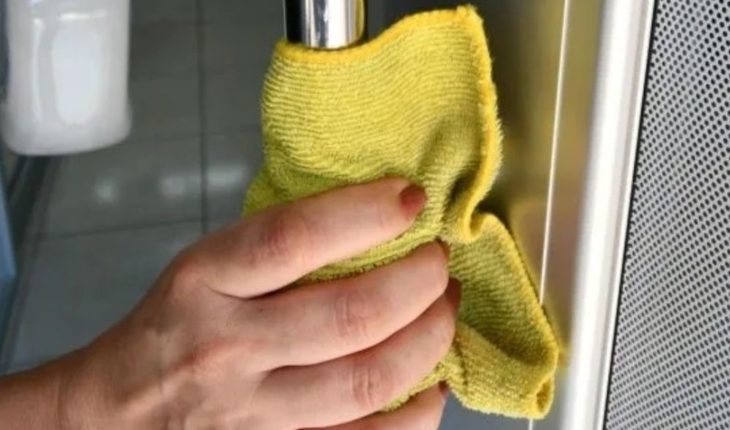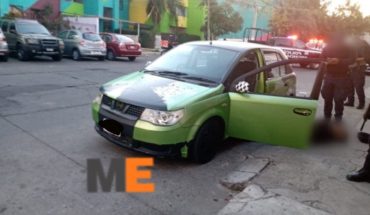
Mexico.- Up to one hundred million viral particles can be found in only one milliliter of substance expected by a person sick with coronavirus, so it sounds logical that one of the most effective forms of transmission of this new infection is person-to-person, coming into contact with saliva and mucus particles that come out of someone with the condition. According to an article published by G. Kampf and collaborators from the Institute of Hygiene and Environmental Medicine of the University of Medicine in Greifswald, Germany, it is already known that SARS-CoV-2, can also be acquired by touching surfaces where this virus has been deposited by people carrying the virus, when they sneeze, spit or touch their nose and mouth without having before or after hygienic precautions.
The virus is known to remain viable for two to nine hours on different surfaces, from plastic to steel. Therefore increasing hygienic measures is important to reduce the contagions of Wuhan pneumonia, including continuously disinfecting surfaces with suitable and efficient substances for this purpose.THE DEBATE carried out a review of the way in which some common substances are used that can be allied when cleaning at home and common spaces at work. COVID-19 prevention
The World Health Organization reports that it is necessary to ensure that environmental cleaning and disinfection procedures are consistently and correctly followed and that when cleaning environments it is carried out with water and detergents, as well as with the application of disinfectants commonly used in hospitals, such as sodium hypochlorite, alcohol and oxygenated water, which are effective and efficient. In addition to WHO, the U.S. Center for Disease Control and Prevention (CDC) and the Mexican Secretary of Health also recommend continuing to pay attention to hand cleaning, and advises washing them frequently with soap and water for at least 20 seconds or cleaning them with a hand sanitizer containing between 62 and 70 percent alcohol, covering the entire surface of your hands and rubbing them until you have felt dry.” If your hands are visibly dirty, it is preferable to use soap and water. Avoid touching your eyes, nose and mouth with unwashed hands,” the CDC says, in place. It is preferable to use skin care compatible products for hand disinfection, to avoid irritation. Sodium hypochlorite to disinfect
If the purpose is to clean at home and eliminate coronavirus, among commercial solutions scientifically proven to remove microorganisms and infectious particles such as surface viruses, bleach that contain sodium hypochlorite are most efficient, also known as “chlorine” or lavender. Sodium hypochlorite is a substance capable of removing viruses and bacteria if it is in the right concentrations. The Medical University of Greifswald Germany mentions in a study that for solutions with sodium hypochlorite to be effective they must be at a minimum concentration of one per cent of this substance, and because common bleach have a concentration of at least five percent of this active substance, it is advisable to make mixtures using a chlorine part plus four parts of water, that is, for each litre of common bleach put four liters more water. You can use cups or other containers to measure the quantities, as long as you respect the proportion of containing one part of bleach for every five of the solution to be made. Some precautions when using chlorine
To be effective the solution chlorinated by one percent, Greifswald researchers mention that it should be kept at least one minute on the surface to disinfect.As the bleach can discolor fibers and tissues should be used with caution; you should avoid mixing with soaps or other substances at the time of use, as it can release gases that may be toxic, in addition to losing effectiveness. A clean and wetted flannel can be used with the preparation to distribute the solution on the surfaces to be disinfected. Websites of brands such as Cloralex and Clorox share their disinfection tips at the same time as the precautions for using their products, for example, avoid contact with eyes and mucous membranes. Alcohol against SARS-CoV-2
Ethyl alcohol, or ethanol, is also very useful when making disinfection, according to the research of G. Kampf and collaborators, it must be at a concentration of 62 to 71 percent to be effective against coronavirus, that is, it must be diluted with water for it to work, since according to a laboratory manual from the Autonomous University of Mexico, the water used to make the dilutions helps the alcohol to remain in solution and penetrate the surface of the viral particles , while alcohol with a high degree of purity does not work because it is volatilized rather than destroying infectious particles and would be producing a drying effect on them. This is avoided when alcohol is diluted with water in the amounts already mentioned. Other alcohols may also be effective, but the most common and easiest to acquire is ethyl alcohol. There is a wide range of products on the market that contain alcohol in the right concentrations to be effective against microorganisms and viruses, be sure to read the labels to carry the right product. How to use alcohol
To clean surfaces we can use alcohol in concentrations that can already come in cleaning products, such as wipes and typical bottles of this solution. If you only find bottles of alcohol with concentrations of 96 degrees, you can prepare a suitable solution in a clean container. A solution with effective concentrations should be close to 70 percent, placing the contents of a 100 milliliter (ml) bottle of alcohol plus 37 ml of distilled water or tap may have a solution with an effective concentration (between 62 and 71 percent). You can also do this by taking 73 ml of 96-degree alcohol and adding 27ml of water to get 100ml of alcohol at approximately 70 percent, the MSF medical guidelines website, provides some instructions for this. This solution can be used by spreading with a sprinkler or a clean flannel or cloth, allowing to act for at least one minute on the surface to be disinfected. The EPSON Foundation’s guide to the use of antiseptics and disinfectants, (http://www.funlarguia.org.ar/), mentions that alcohol should be used with caution, as it can irritate open wounds, as well as eyes and mucous membranes and how it is flammable it should be handled away from fire. Avoid mixing with other substances. Oxygenated water is also effective
The institute of hygiene and environmental medicine at Greifswald Medical University mentions that oxygenated water is effective under concentrations of five percent, however, in pharmacies it is most common to find oxygenated water that has a concentration of hydrogen peroxide of 3 percent, so a mixture will also have to be made to have the proper concentration of this substance that is effective against coronavirus. Make a mixture of 100 ml of oxygenated water at three percent plus 500 ml of distilled water or the garraphon. The portal Takes Care Plus in its article uses oxygenated water and recommendations for its use, mentions that hydrogen peroxide can discolour hair fibers and depigment some fabrics. Like the other substances already mentioned, peroxide is irritating and should move away from eyes and mucous membranes or deep wounds. Avoid mixing this solution with other substances. Scientists at Greifswald Germany say that such a solution must be at least one minute in contact with the surface to be disinfected to be effective. Pine oil products
Cleaning products made from pine oil are also useful when removing germs, For example, Pinol recommends using its classic green bottle disinfectant products, directly on surfaces or with the help of a cleaning fabric, and let it work for at least 10 minutes before rinsing it or a clean tissue of fabric or paper, although the brand stresses that its product is effective against some coronaviruses, has not been tested against COVID-19. Is vinegar effective?
Some social media posts suggest that products like white vinegar are useful for disinfecting, but on this occasion THE DEBATE found no scientific evidence to indicate that vinegar may be useful against coronavirus, however, a study conducted by the University of Florida found that if this substance is used in a concentration of 10 percent acetic acid may work against viruses such as polio and bacteriophages, as their study inoculated these viruses on the surface strawberries and it was found that by washing these fruits with white vinegar at ten percent acetic acid, it could remove at least 95% of the viral particles into these fruits. However, not all brands of commercial vinegar have products with acetic acid in these concentrations, so their use is not recommended, in addition, extreme precautions should be taken, since being an acidic product, it is very irritating and volatile, the vapors can easily irritate eyes and mucous membranes and being in contact with the skin can also be damaged. You can learn more about this substance by visiting www.acidoacetico.org.Soap descorona at SARS-CoV-2
Of the disinfection items you know soap is one of the most effective, economical and affordable against COVID-19. In the article “The Chemistry of Soap and Some Applications,” by the digital magazine UNAM university, explain that soap is basically a paste containing sodium or potassium salts of some fatty acids, whose molecules have two extremes: a tail that adheres to fats and repels water and a molecular head that is easily attracted to the aqueous solution (they are bipolar or ampophysitic). Scientist Pall Thordarson, a chemist at the University of Iceland, explained in his social media that the nature of soap allows it to easily dissolve fats, and because coronaviruses are basically nanospheres composed of proteins and fats on the outside, soap particles degenerate the capss or coverage of the virus, while making it easier for the viruses and molecules that make up them to be removed by water from surfaces such as the skin. Pall comments that any soap has these qualities and in this case it is not necessary to buy any with antibacterial or other specific substances, since what makes them effective is their nature, it is only necessary to do the washing correctly (Sources: Twitter@PalliThordarson and UNAM, 2014). Cell Phone Cleaning
As alcohol is a commonly used disinfectant, on its website, APPLE recommends using alcohol-based disinfectant wipes to disinfect your brand electronics, just as logic can be adapted to other electronics at home.
40 Seconds; According to experts, it is the time that rounds clean hands properly with alcohol gel from 62 to 70 percent, to inhibit the spread of COVID-19.
Persistence: Coronavirus on surfaces
A study ensures that coVID-19 virus persists on surfaces such as 2-3-day plastic; cardboard, 1 day; paper, 4-5 days; glass, 4 days; latex gloves, 8 hours, at temperatures of 23 degrees Celsius ( Other studies show that VIRUSes in the COVID-19 family (SARS-VOC-2) have a high persistence on multiple surfaces, some can persist more than 24 hours at temperatures of more than 20oC. For example, the MERS-VOC virus (Middle East Respiratory Syndrome virus) lasts on surfaces up to 48 hours at 20oC and eight to 24 hours at temperatures of 30oC on steel surfaces and indoor temperatures can remain for up to five days. The TGEV virus (pig transmissible gastroenteritis virus) can be 4 to 96 hours at 40 degrees Celsius on steel surfaces. Remember: disinfecting is key to eliminating them (Van Doremalen, N., Bushmaker, T., Morris, D. H., Holbrook, M. G., Gamble, A., Williamson, B.N., … & Lloyd-Smith, J.O. (2020); Kampf, G., Todt, D., Pfaender, S., & Steinmann, E. (2020).





